The Path of an Aspiring Assistance Dog
Lise Miltner (STH’17) raises prospective assistance dog Gem
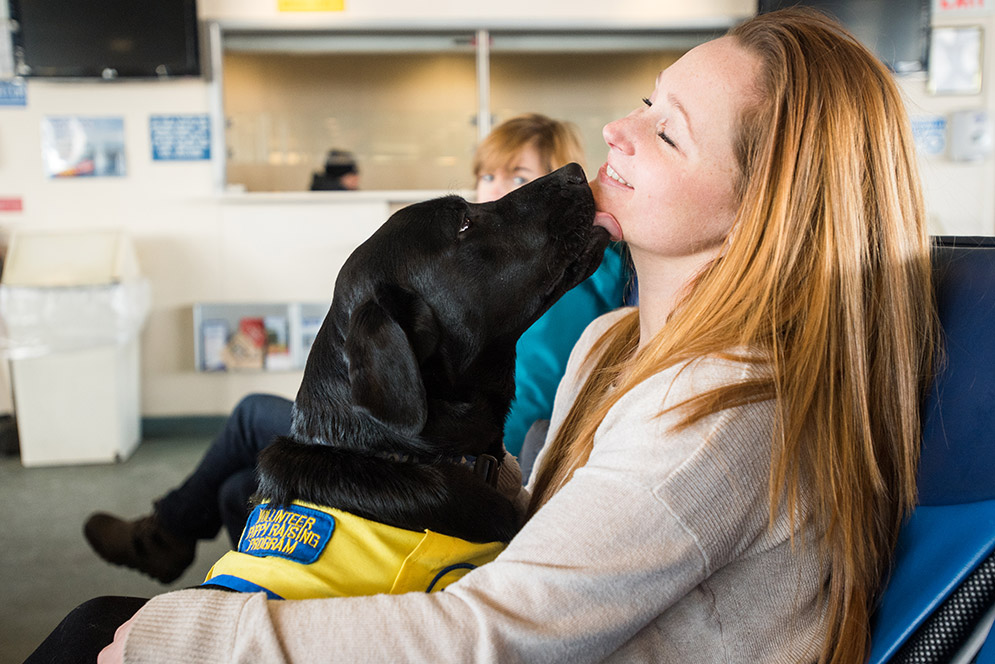
Lise Miltner (STH’17) and Gem, the Labrador retriever she spent 16 months training to be an assistance dog, on their way to the Canine Companions for Independence graduation ceremony February 10, 2017. Gem is getting additional training there since graduating.
What began as a fourth grade report wound up changing the course of Lise Miltner’s life. Growing up in the San Francisco Bay area, Miltner (STH’17) did a homework assignment on an organization that was training prison inmates to raise assistance dogs, defined by the Americans with Disabilities Act as those who “are individually trained to do work or perform tasks for people with disabilities.” Miltner was hooked. “I wanted to help people by raising service dogs. It’s something I always had in the back of my mind,” she says.
Fast forward to September 2015. Miltner, who was earning a Master of Divinity at the School of Theology, had gotten in touch with Canine Companions for Independence, the nonprofit she had written about as a fourth grader, which provides highly trained assistance dogs to people with disabilities. She wanted to become a volunteer puppy raiser.

Miltner (from left), Gem, Mary Mortenson (STH’19), Leticia Trujillo (STH’19), Isaac Martinez, and Eun Su Kim (STH’19) at an STH class taught by Courtney Goto September 28, 2016.
She was paired with 10-week-old Gem, a female black Labrador retriever. Like most lab puppies, she was a little goofy, but sweet and wonderful. Thus began a special relationship.
Over the next 16 months, Miltner and Gem were inseparable.
In addition to raising the growing puppy, giving her lots of love, and teaching her manners and more than 40 basic commands, one of Miltner’s biggest responsibilities was to provide her with adequate socialization—exposing her to different types of surroundings to prepare her for a possible life as an assistance dog. The two could be spotted on the T en route to a vet’s appointment, walking to and from home along Comm Ave, in classrooms at STH, even at FitRec, where Miltner takes ballet classes. She says students loved seeing Gem around campus. Ditto professors.

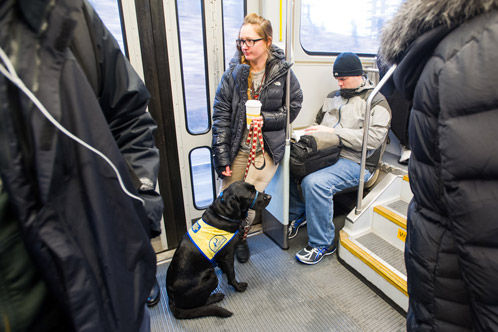
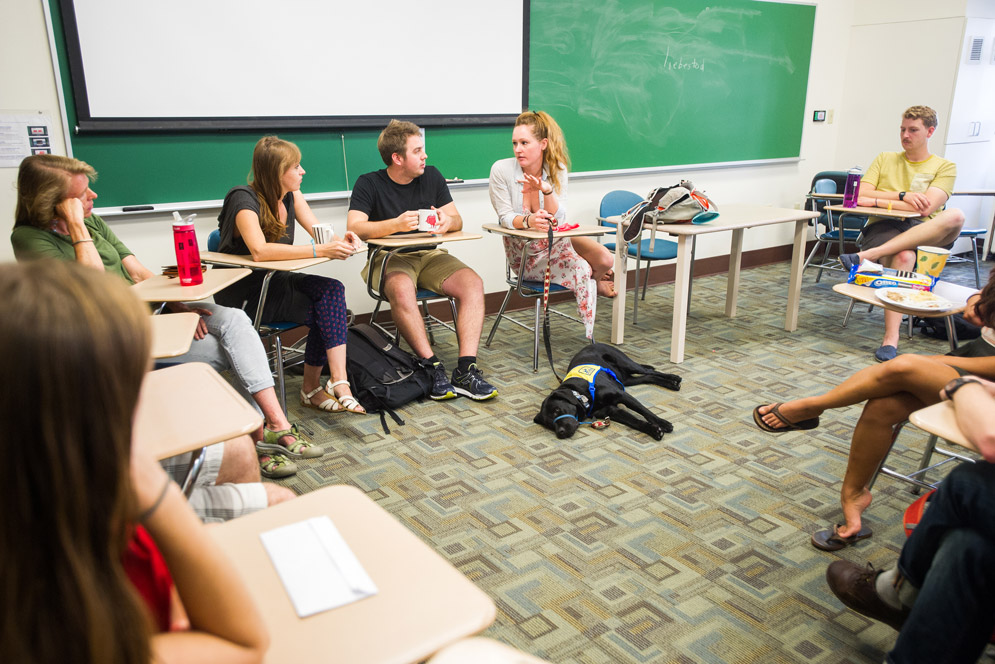
Clockwise from top left: Miltner (second from left) and Gem at a holiday party at the home of Lindsey Nielsen (STH’18) (far left), December 9, 2016. On the T, en route to the vet’s office to pick up heartworm and flea treatment, which Miltner pays for out of pocket. Miltner and Gem at a September 21, 2016, meeting of the Interfaith Club, which Miltner founded at STH.
At the beginning of each semester, Miltner emailed faculty and staff to let them know she was raising an assistance dog. “It’s always very important as a puppy raiser to make sure you are working with the place you’re going into and not just barging in,” she explains. Most professors agreed readily, others just asked that she make sure the other students were comfortable with the situation.
Courtney Goto, an STH assistant professor of religious education, was an immediate fan, and says Gem earned an A for good behavior. “Gem was a wonderful presence in our classroom. My class starts with stretches and body movement, and Gem was always up on all fours, looking up with big wondering eyes. When we were in discussion, she was always quiet, laying down behind Lise’s chair. She was just part of our learning community.”
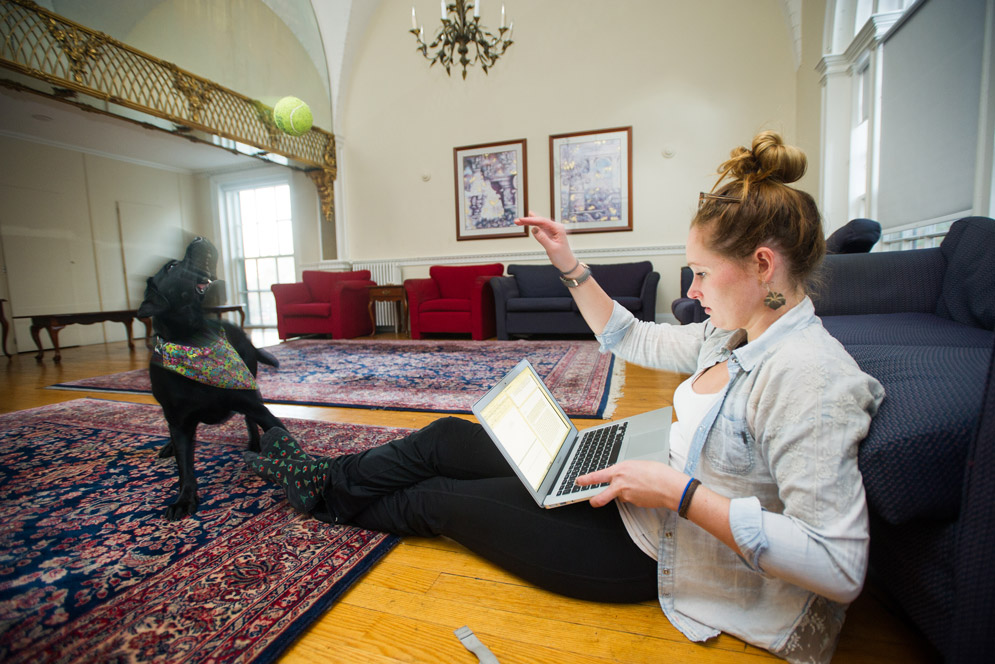
Multitasking: Miltner and Gem at Theology House November 4, 2016.
Miltner will tell you that raising a prospective assistance dog is not all treats and tail wags. “I’ve sacrificed a lot,” she concedes. “I would say that I basically arranged my life around Gem.” The volunteer puppy raisers are expected to supervise their young charges throughout the day. It’s not easy when you’re pursuing a full-time master’s degree and working a night shift as an EMT. On nights when she had to work, a friend would watch Gem or she’d crate her. And while Canine Companions covered Gem’s initial shots and helped reimburse Miltner for some veterinary bills, she was responsible for paying for Gem’s food, additional booster shots, travel, toys, training treats, and grooming supplies.
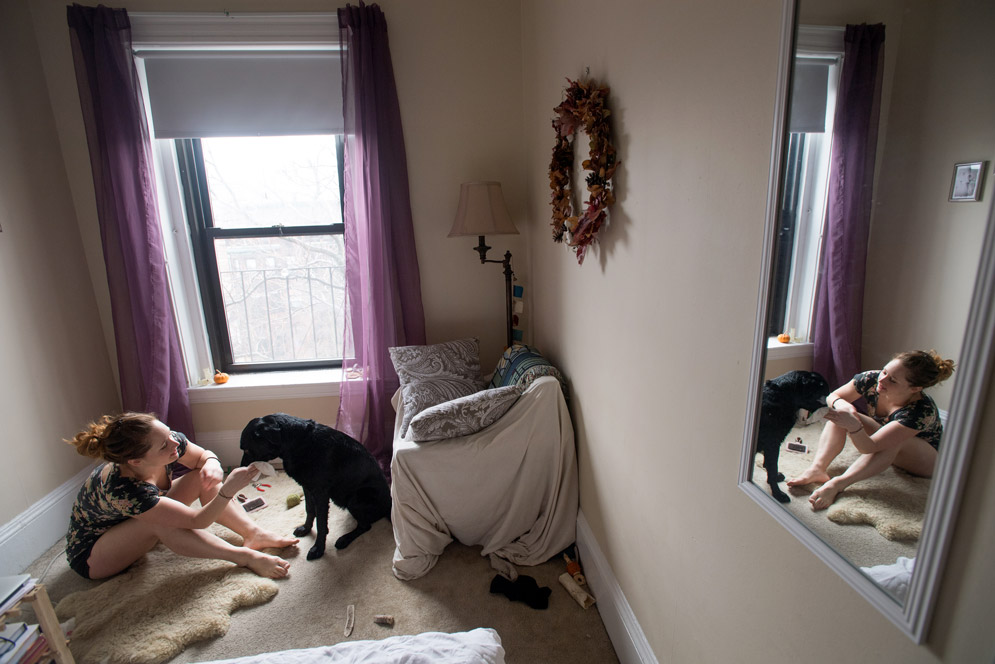
Miltner grooming Gem February 8, 2017, before bringing her to Canine Companions for graduation. “I want her looking her best,” Miltner says.
Last month, after nearly a year and a half of training and bonding, Miltner and Gem traveled to Long Island to Canine Companions’ Northeast Training Center in Medford, N.Y. It was a day Miltner had been working toward—and dreading. She would walk Gem across a stage during a formal matriculation ceremony before handing her over for six months of advanced training with Canine Companions’ nationally renowned instructors. Those dogs who make the grade are matched with a person on the organization’s wait list. If the two are deemed a good match after meeting in person, they then go through a two-week training session at Canine Companions’ campus, where they learn to work together. Not every dog passes the test. In fact, only 4 out of 10 make it through the entire program.
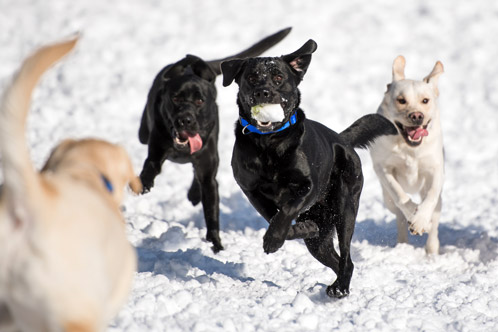
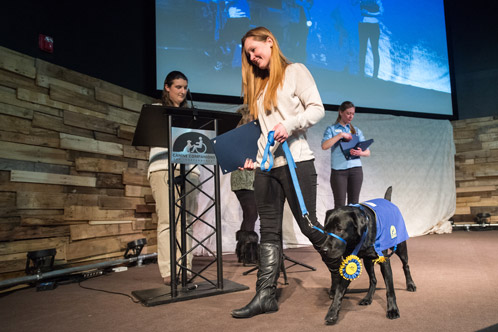
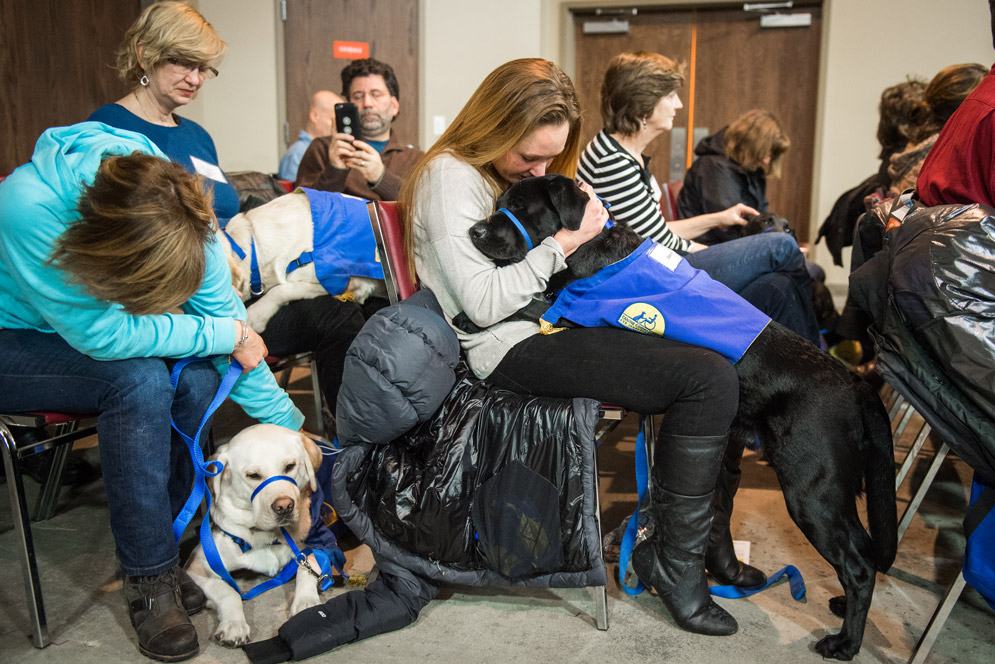
Clockwise from top left: Gem and friends: assistance dogs in training at the Canine Companion’s Northeast Training Center dog park in Medford, N.Y., February 10, 2017. Participating in the Canine Companions graduation ceremony February 10 were 28 assistance-dogs-in-training and their trainers; Gem earned a medallion for completing the first phase of assistance dog training and Miltner received a certificate. Gem and Miltner (center) at the graduation ceremony.
Those who do make it are trained to serve one of four functions: as service dogs, assisting adults with physical disabilities by performing daily tasks; as hearing dogs, alerting their deaf or hard-of-hearing partner to important sounds; as a facility dog, working with clients with special needs in a variety of settings; or as a skilled companion, enhancing independence for children and adults with physical, cognitive, and developmental disabilities.
The handing off is an emotional moment. Miltner knew what to expect, because she’s been through it before. “I start being sad about it months before the day,” she says. Gem is the second assistance dog she has helped train. When she was living in LA five years ago, she raised Lemon, another Canine Companions assistance-dog-in-training. Lemon, it turns out, earned such high marks in the program that she is now a breeding dog for the organization, a distinction only 5 percent of assistance dogs attain.
People Love Gem
“Everyone at STH loves her. She has a lot more friends than I do. People will be like, ‘Hi, Gem,’ and they won’t say hi to me.”
Lise Miltner(Gem's trainer)
Audio — 33 SecondsAs Miltner waits to give Gem over to her new instructor, she learns something that softens the day’s hard edge: Lemon has had four litters, and one of her offspring has become a search and rescue dog and two more are now skilled companions. It’s a reminder of the importance of the work Miltner has spent the last 16 months doing.
“You spend all this time training your dog, and sometimes it can be hard to feel connected to that higher purpose,” she says. “This day is a reminder of the gift I’m going to be able to give someone. That’s why I do it.”
After a long day of anxious anticipation, tears, and last-minute snuggles, Gem is handed off to her new instructor, padding towards her next chapter. Gem doesn’t look back. Her future is still unclear, but Miltner has a hunch of what’s in store.
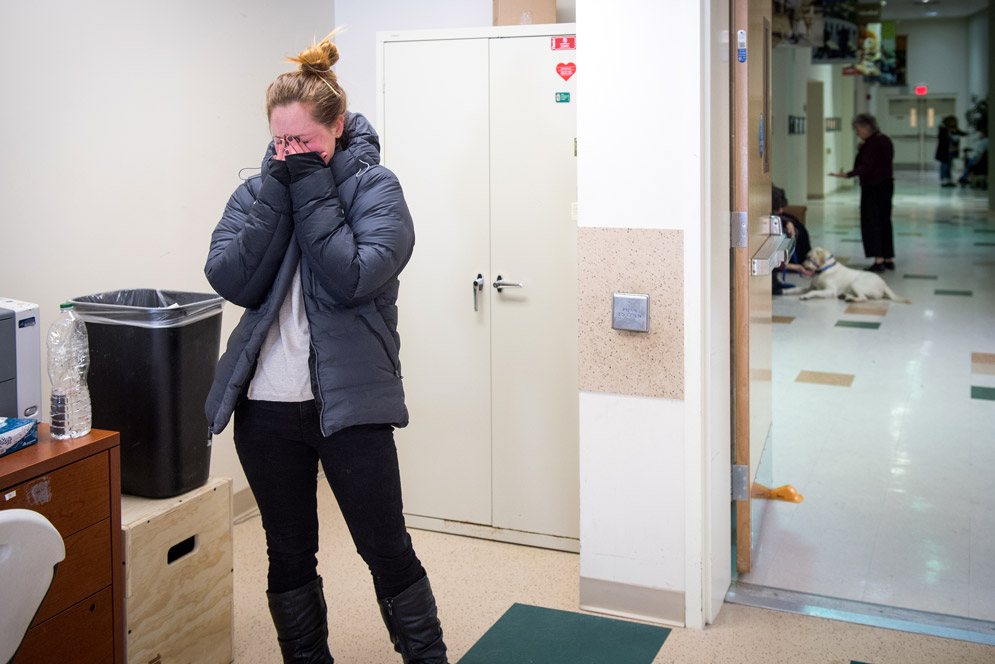
Bittersweet moment: “I didn’t realize how much light she brought to my life until now. That sounds a little melodramatic, but I mean it,” Miltner says. “I miss her a lot.”
“Gem is very strong-willed, but she’s very sensitive and highly reactive. That can make her difficult to train, but my hope is that Canine Companions will see those qualities as positive attributes, that maybe she’ll be a good candidate for their hearing dog program…That’s my hope for her.”
Learn more about training a Canine Companions for Independence assistance dog here.

Comments & Discussion
Boston University moderates comments to facilitate an informed, substantive, civil conversation. Abusive, profane, self-promotional, misleading, incoherent or off-topic comments will be rejected. Moderators are staffed during regular business hours (EST) and can only accept comments written in English. Statistics or facts must include a citation or a link to the citation.